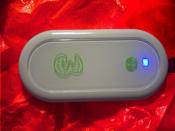David Rosenberg Tuesday, April 29, 2008 David Rosenberg, page � PAGE \* MERGEFORMAT �5� Mobile Technology: A Culture Which Defines Our Generation
Mobile Technology: A Trend Defining the Culture of Today
While wireless data has always enticed us with a tantalizing vision of always-connected mobile computing, adoption has been slower than for voice services. In the past several years, however, adoption has accelerated, and thanks to a number of key developments. Networks themselves are much more capable, delivering higher throughputs at lower cost. Awareness of data capabilities has increased, especially through the pervasive success of SMS, wireless email, downloadable ringtones, and downloadable games. Widespread availability of services has also been important. The features found in cellular telephones are expanding at a rapid rate, and today include large color displays, graphics viewers, still cameras, movie cameras, MP3 players, instant messaging clients, email clients, downloadable executable content capability, and browsers supporting multiple formats.
All of these capabilities consume data. Meanwhile, smartphones, with their emphasis of a rich computing environment on the phone, represent the convergence of 1) the personal digital assistant; 2) a fully capable mobile computer; and 3) a phone in a device that is only slightly larger than the average cellular telephone. Many users would prefer to carry one device that does it all.
Wireless data is becoming more important to enterprise companies. About 20% of IT budgets are dedicated to wireless data, which was defined as including wireless LAN and wireless wide area network (WAN) equipment and services. About half of mid-size and large enterprises use wireless data today and another 30% are planning and evaluating future use. Three quarters of current WAN data users plan to increase their usage in the future.
Common wireless data applications include email, access to the web, spreadsheets, and word processing documents.


